
- UMTS Tutorial
- UMTS - Home
- History of Mobile Communication
- Cellular Concepts
- Cellular Concepts - Introduction
- GSM Architecture
- Cellular Concepts - GSM Radio Link
- Cellular Concepts - Mobility
- Cellular Concepts - GPRS
- Cellular Concepts - EDGE
- UMTS Introduction
- UMTS - A New Network
- UMTS - WCDMA Technology
- UMTS - HSPA Standardization
- UMTS - Objectives
- UMTS - Authentication
- UMTS - Success and Limitations
- UMTS Networks Standardization
- UMTS - 3GPP
- UMTS - Radio Access Network
- UMTS - Evolved Packet Core
- UMTS Protocol Environment
- UMTS - GPRS Tunneling Protocol
- UMTS - Proxy Mobile IPv6
- UMTS - EAP
- UMTS - IKEv2 & MOBIKE
- UMTS - SCTP
- UMTS - NAS Signaling Protocol
- UMTS Useful Resources
- UMTS - Quick Guide
- UMTS - Useful Resources
- UMTS - Discussion
Cellular Concepts - Mobility Management
The mobile station attempts to find a suitable cell by passing through the list in descending order of received signal strength, the first BCCH channel, which satisfies a set of requirements it has selected.
Cell Selection Criteria
The requirements that a cell must satisfy before a mobile station can receive service from it are −
It should be a cell of the selected PLMN. The mobile station checks whether the cell is part of the selected PLMN.
It should not be "barred". The PLMN operator may decide not to allow mobile stations to access certain cells. These cells may, for example only be used for handover traffic. Barred cell information is broadcast on the BCCH to instruct mobile stations not to access these cells.
The radio path loss between the mobile station and the selected BTS must be above a threshold set by the PLMN operator.
If no suitable cell is found then the MS enters a "limited service" state in which it can only make emergency calls.
Call to an Active Mobile Station
As an active mobile station (MS) moves in the coverage area of a public land mobile network (PLMN), it reports its movements so that it can be located as needed, using the update procedure locations. When a mobile services switching center (MSC) in the network needs to establish a call to a mobile station operating in its flow area, following things occur −
A page message its broadcast which contains the identification code of the MS. Not every Base Station Controller (BSC) in the network is requested to transmit the page message. The broadcast is limited to a cluster of radio cells that together form a location area. The last reported position of the MS identifies the location area to be used for the broadcast.
The MS monitors the page message transmitted by the radio cell in which it is located and, on detecting its own identification code, responds by transmitting a page response message to the Base Transceiver Station (BTS).
Communication is then established between the MSC and the MS via BTS that received the page response message.
Location Update
Case 1 − Location never updates.
If location never updates the implementation for location update, cost becomes zero. But we have to page every cell for locating the MS and this procedure will not be cost effective.
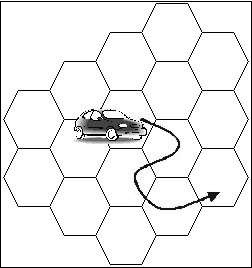
Case 2 − Location update is implemented.
Location updates are taking place as per the requirements of the network, may be time or movement or distance based. This procedure involves high cost, but we have to page single cell or few cells only for locating the MS and this procedure will be cost effective.
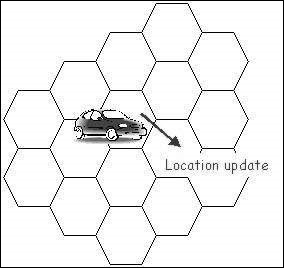
Network Configuration
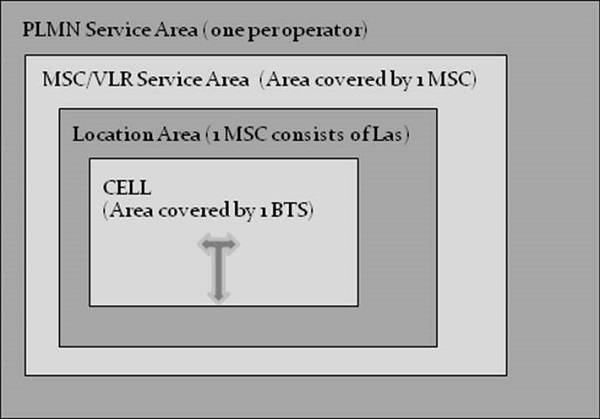
The configuration of a Public Land Mobile Network (PLMN) is designed so that active mobile station moving in the network area is still able to report its position. A network consists of different areas −
- PLMN area
- Location area
- MSC area
- PLMN Area
A PLMN area is the geographical area in which land mobile communication services are provided to the public by a particular PLMN operator. From any position within a PLMN area, the mobile user can set up calls to another user of the same network, or to a user of another network. The other network may be a fixed network, another GSM PLMN, or another type of PLMN. Users of the same PLMN or users of other networks can also call a mobile user who is active in the PLMN area. When there are several PLMN operators, the geographical areas covered by their networks may overlap. The extent of a PLMN area is normally limited by national borders.
Location Area
To eliminate the need for network-wide paging broadcasts, the PLMN needs to know the approximate positions of the MSs that are active within its coverage area. To enable the approximate positions of any MS to be represented by a single parameter, the total area covered by the network is divided into location areas. A Location Area (LA) is a group of one or more radio cells. This group fulfills the following requirements −
BTSs in one location area may be controlled by one or more BSCs.
BSCs those serve the same location area are always connected to the same MSC.
Radio cells with BTSs controlled by a common BSC can lie in different location areas.
Location Area Identity
Every radio transmitter in the PLMN broadcast, via a control channel BCCH, a Location Area Identity (LAI), code to identify the location area that it serves. When an MS is not engaged in a call, it automatically scans the BCCH transmitted by the base stations in the locality and selects the channel that is delivering the strongest signal. The LAI code broadcast by the selected channel identifies the location area in which the MS is currently situated. This LAI code is stored in the Subscriber Identity Module (SIM) of the mobile equipment.
As the MS moves through the network area, the signal received from the selected control channel gradually diminishes in strength until it is no longer the strongest. At this point the MS re-tunes to the channel that has become dominant and examines the LAI code that it is broadcasting. If the received LAI code differs from that stored on the SIM, then the MS has entered another location area and initiates a location update procedure to report the change to the MSC. At the end of the procedure, the LAI code in the SIM is also updated.
Location Area Identity Format
It is a Location Area Identity (LAI) code to identify the location area in a PLMN. The LAI code has three components −
Mobile Country Code (MCC)
The MCC is a 3-digit code that uniquely identifies the country of domicile of the mobile subscriber (for example, India 404). It is assigned by the ITU-T.
Mobile Network Code (MNC)
The MNC is a 2-digit code (3-digit code for GSM-1900) that identifies the home GSM PLMN of the mobile subscriber. If more than one GSM PLMN exists in a country, a unique MNC is assigned to each of them. It is assigned by the government of each country. (For example Cell one, Chennai 64).
Location Area Code (LAC)
The LAC component identifies a location area within a PLMN; it has a fixed length of 2 octets and can be coded using hexadecimal representation. It is assigned by an operator.
MSC areas
An MSC area is a region of the network in which GSM operations are controlled by a single MSC. An MSC area consists of one more location areas. The boundary of an MSC area follows the external boundaries of the location areas on its periphery. Consequently, a location area never spans beyond the boundary of an MSC area.
VLR area
A VLR area is region of the network that is supervised by a single Visitor Location Register (VLR). In theory, a VLR area may consist of one more MSC areas. In practice, however the functions of the VLR are always integrated with those of the MSC so that the terms "VLR area" and "MSC area" have become synonymous.
Location Related Databases
Two databases are used by Location Management to store MS location related data.
- Visitor Location Register(VLR)
- Home Location Register(HLR)
Visitor Location Register
A VLR contains a data record for each of the MS that are currently operating in its area. Each record contains a set of subscriber identity codes, related subscription information, and a Location Area Identity (LAI) code. This information is used by the MSC when handling calls to or from an MS in the area. When an MS moves from one area to another, the responsibility for its supervision passes from one VLR to another. A new data record is created by the VLR that has adopted the MS, and the old record is deleted. Provided that aninter-working agreement exists between the network operators concerned, data transaction can cross both network and national boundaries.
Home Location Register
The HLR contains information relevant to mobile subscribers who are fee-paying customers of the organization that operates the PLMN.
The HLR stores two types of information −
Subscription Information
The subscription information includes the IMSI and directory number allocated to the subscriber, the type of services provided and any related restrictions.
Location Information
The location information includes the address of the VLR in the area where the subscribers MS is currently located and the address of the associated MSC.
The location information enables incoming calls to be routed to the MS. The absence of this information indicates that the MS is inactive and cannot be reached.
When an MS moves from one VLR area to another, the location information in the HLR is updated with the new entry for the MS, using subscription data copied from the HLR. Provided that an inter-working agreement exists between the network operators, concerned data transactions can move across both network and national boundaries.
Types of Identification Numbers
During the performance of the location update procedure and the processing of a mobile call different types of numbers are used −
- Mobile Station ISDN Number(MSISDN)
- Mobile Subscriber Roaming Number(MSRN)
- International Mobile Subscriber Identity(IMSI)
- Temporary Mobile Subscriber Identity(TMSI)
- Local Mobile Station Identity(LMSI)
Each number is stored in the HLR and/or VLR.
Mobile Station ISDN Number
The MSISDN is the directory number allocated to the mobile subscriber. It is dialed to make a telephone call to the mobile subscriber. The number consists of Country Code (CC) of the country in which the mobile station is registered (e.g. India 91), followed by national mobile number which consists of Network Destination Code (NDC) and Subscriber Number (SN). An NDC is allocated to each GSM PLMN.
The composition of the MSISDN is such that it can be used as a global title address in the Signaling Connection Control Part (SCCP) for routing message to the HLR of the mobile subscriber.
Mobile Station Roaming Number
The MSRN is the number required by the gateway MSC to route an incoming call to an MS that is not currently under the control of the gateway MSISDN. Using a mobile, terminated call is routed to the MSC gateway. Based on this, MSISDN gateway MSC requests for a MSRN to route the call to the current visited MSC International Mobile Subscriber Identity (IMSI).
An MS is identified by its IMSI. The IMSI is embedded in the SIM of the mobile equipment. It is provided by the MS anytime it accesses the network.
Mobile Country Code (MCC)
The MCC component of the IMSI is a 3-digit code that uniquely identifies the country of the domicile of the subscriber. It is assigned by the ITU-T.
Mobile Network Code (MNC)
The MNC component is a 2-digit code that identifies the home GSM PLMN of the mobile subscriber. It is assigned by the government of each country. For GSM-1900 a 3-digit MNC is used.
Mobile Subscriber Identification Number (MSIN)
The MSIN is a code that identifies the subscriber within a GSM PLMN. It is assigned by the operator.

Temporary Mobile Subscriber Identity (TMSI)
The TMSI is an identity alias which is used instead of the IMSI when possible. The use of a TMSI ensures that the true identity of the mobile subscriber remains confidential by eliminating the need to transfer a non ciphered IMSI code over a radio link.
A VLR allocates a unique TMSI code to each mobile subscriber that is operating in its area. This code which is only valid within the area supervised by the VLR is used to identify the subscriber, in messages to and from the MS. When a change of location area also involves a change of VLR area, a new TMSI code is allocated and communicated to the MS. The MS stores the TMSI on its SIM. The TMSI consists of four octets.
Location Update Scenario
In the following location update scenario, it is assumed that an MS enters a new location area that is under control of a different VLR (referred to as the "new VLR") than the one where the MS is currently registered (referred to as the "old VLR"). The following diagram shows the steps of the mobile location update scenario.
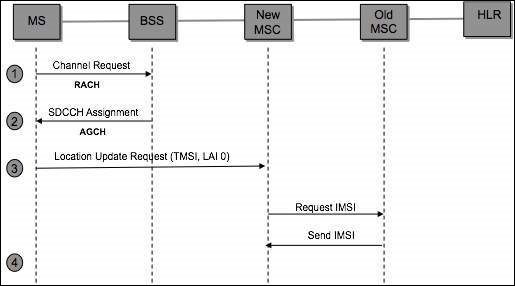
The MS enters a new cell area, listens to the Location Area Identity (LAI) being transmitted on the broadcast channel (BCCH), and compares this LAI with the last LAI (stored in the SIM) representing the last area where the mobile was registered.
The MS detects that it has entered a new Location Area and transmits a Channel Request message over the Random Access Channel (RACH).
Once the BSS receives the Channel Request message, it allocates a Stand-alone Dedicated Control Channel (SDCCH) and forwards this channel assignment information to the MS over the Access Grant Channel (AGCH). It is over the SDCCH that the MS will communicate with the BSS and MSC.
The MS transmits a location update request message to the BSS over the SDCCH. Included in this message are the MS Temporary Mobile Subscriber Identity (TMSI) and the old Location Area Subscriber (old LAI). The MS can identify itself either with its IMSI or TMSI. In this example, we will assume that the mobile provided a TMSI. The BSS forwards the location update request message to the MSC.
The VLR analyses the LAI supplied in the message and determines that the TMSI received is associated with a different VLR (old VLR). In order to proceed with the registration the IMSI of the MS must be determined. The new VLR derives the identity of the old VLR by using the received LAI, supplied in the location update request message. It also requests the old VLR to supply the IMSI for a particular TMSI.
Location Update Scenario-Update HLR/VLR is a point where we are ready to inform the HLR that the MS is under control of a new VLR and that the MS can be de-registered from the old VLR. The steps in update HLR/VLR phase are −
The new VLR sends a message to the HLR informing it that the given IMSI has changed locations and can be reached by routing all incoming calls to the VLR address included in the message.
The HLR requests the old VLR to remove the subscriber record associated with the given IMSI. The request is acknowledged.
The HLR updates the new VLR with the subscriber data (mobiles subscribers’ customer profile).
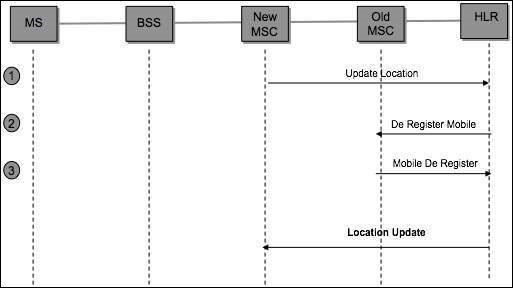
Steps in TMSI Reallocation Phase
The MSC forwards the location update accept message to the MS. This message includes the new TMSI.
The MS retrieves the new TMSI value from the message and updates its SIM with this new value. The mobile then sends an update complete message back to the MSC.
The MSC requests from the BSS, that the signaling connection be released between the MSC and the MS.
The MSC releases its portion of the signaling connection when it receives the clear complete message from the BSS.
The BSS sends a "radio resource" channel release message to the MS and then free up the Stand-alone Dedicated Control Channel (SDCCH) that was allocated previously. The BSS then informs the MSC that the signaling connection has been cleared.
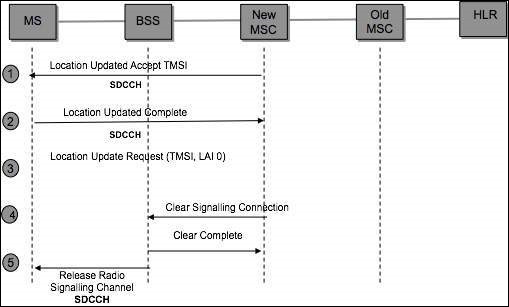
Location Update Periodicity
Location Update automatically takes place when the MS changes its LA. A lot of location updates may be generated if a user crosses LA boundary frequently. If the MS remains in the same LA, Location Update may take place based on time/movement/distance, as defined by the network provider.
Hand Over
This is the process of automatically switching a call in progress from one traffic channel to another to neutralize the adverse effects of the user movements. Hand over process will be started only if the power control is not helpful anymore.
The Hand Over process is MAHO (Mobile Assisted Hand Over). It starts with the Down Link Measurements by the MS (Strength of the signal from BTS, Quality of the signal from BTS). MS can measure the signal strength of the 6 best neighboring BTS downlink (candidate list).
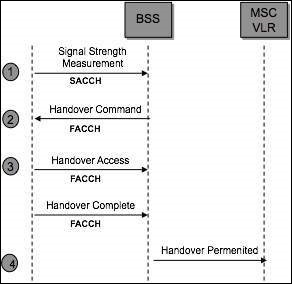
Hand Over Types
There are two types of Hand Over −
-
Internal or Intra BSS Handover
Intra-cell hand over
Inter cell hand over
-
External or Inter BSS Hand over
Intra-MSC hand over
Inter MSC hand over
Internal handover is managed by the BSC and external handover by MSC.
The objectives of Hand Over are as follows −
- Maintain a good quality of speech.
- Minimize number of calls dropped.
- Maximize the amount of time the mobile station is in the best cell.
- Minimize the number of hand overs.
When will a Hand Over take place?
- Distance (propagation delay) between the MS and BTS becomes too big.
- If the received signal level is very low.
- If the received signal quality very low.
- Path loss situation for the mobile station to another cell is better.